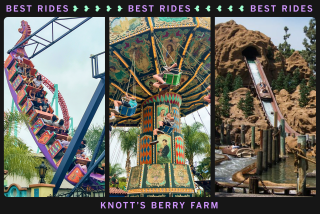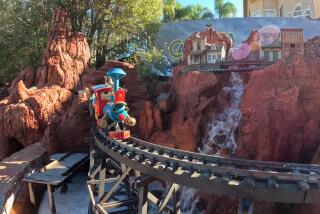A Horse of Course
SANTA ANA — Sy Vaks was headed into the frenzied high-tech world of computers and electronics until he did an about-face, opting for an old-world business that thrives on slow, meticulous attention to detail.
His Santa Ana-based company is one of the few that carves wooden horses and other carousel figures. Last year, American Carousel Collection and its affiliates sold 1,000 of these wooden figures, a 20% increase from the previous year.
“Everybody loves the old wooden horses,” Vaks says.
“They are really coming back as a nostalgia sort of item,” agrees his cousin, Sid Askari, who heads the company’s day-to-day operations. Prestigious retailers such as FAO Schwartz are now peddling the company’s wares in stores and catalogs, and celebrities such as Michael Jackson and Elizabeth Taylor have become customers.
But Vaks’ small business isn’t poised for rapid growth. The marketing staff consists of Askari and Vaks’ wife, Sue, and the company relies solely on word-of-mouth advertising and trade-show appearances to sell its products. Most of the 12 employees are craftsmen who spend 40 to 60 hours carving and painting each horse, rabbit, lion or other carousel favorite.
“We’d like to grow . . . if we could find a good way,” Askari said. “But maintaining the quality is the most important thing. These figures aren’t mass-produced, they are like artwork.”
It’s difficult to find skilled artisans to carve the intricate figures. And even the most experienced woodworkers require another six months of one-on-one training by Vaks just to learn the basics of the lost art.
“Carving carousels is a lot different than carving furniture parts,” Askari said.
This time-consuming labor coupled with costly supplies--the company carves figures out of blocks of treated wood--can eat into profits.
Indeed, experts say only a dozen U.S. companies make wooden carousel figures. Most are produced in Spain, Mexico and the Philippines, where labor is cheaper.
Vaks’ carousel figures range from 3 to 5 feet in height and cost $700 to $17,000, depending on the size and level of detail.
But there are plenty of people waiting to snap the creatures up.
Carousel figures have become a hot collector’s item again, mainly because they are rare and provide a pleasant link to people’s pasts, said Pam Danziger, president of Unity Marketing, a research firm in Stevens, Pa.
And they are likely to become even more popular over the next few years, she says.
“As we approach the millennium, things that hark back to the beginning of the last century will become more collectible,” Danziger said.
American Carousel also has set its sights on such big-budget customers as mall operators that are considering installing merry-go-rounds to spruce up a center’s image and attract more families. Last year, the company built six carousels, the largest a 26-figure ride with a price tag of $200,000.
Carousels trace their roots to medieval times, when they were used as training devices for knights, who would try to spear hanging rings. In the late 1870s, they started appearing in the United States as family entertainment. Amusement park operators set them up near piers, and trolley companies installed them at picturesque stops along the line to lure more customers. During the Depression, amusement parks closed and merry-go-rounds were dismantled, often winding up in old barns and sheds. They enjoyed a comeback in the 1950s, but were made of cheaper materials such as molded fiberglass and aluminum.
Today, only 153 of the 6,000 antique wooden carousels produced in the United States remain in operation, according to Marianne Stevens, carousel expert and co-author of the book “Painted Ponies.”
The ultimate prize for avid collectors is an antique figure by a master such as Gustav Dentzel or Charles Looff. But these animals are scarce and often command five- and six-figure prices.
For the most part, American Carousel’s customers are simply looking for a slice of Americana to decorate their homes.
The company’s figures “are really popular,” said Susie Lueke, manager of Designs West, a mail-order business that sells to small shops. “Husbands buy them as a gift for their wives, and a lot go to first-born children from their grandparents.
In fact, Vaks learned the trade of woodcarving from his grandfather, an artist who would carve walking canes with the heads of elephants and horses and create toy barking dogs.
When Vaks came to the United States in the early 1970s, he planned to study electronics and computers so he could return to Iran and set up his own company.
But the unstable political climate there forced him to scrap his plans, and Vaks turned to carving.
Operating from a small shop in North Hollywood, he carved rocking horses and statues. He switched to carousel horses full-time in the early 1980s, a move suggested by a Bob Hope secretary who had ordered some horse carvings for the entertainer.
To make each carousel figure, the company uses a single block of treated oak obtained from mills in Northern California and Oregon. The body, head and legs of the animal are cut out into four or five pieces and then designs--flowers, armor, a saddle--are chiseled in. The parts then are glued and connected with dowels. The figure is sanded, primed several times and hand painted.
The process used to take much longer, up to 300 hours, Vaks recalls, before he perfected his technique.
As Vaks built a reputation with gift shops and private collectors, the company expanded.
Askari came on board as chief operating officer, and Vaks eventually hired other carvers, moving the operation to its current headquarters in Santa Ana.
Demand peaked for the figures in the heady 1980s, then plunged along with the rest of the California economy in the early 1990s. But now sales are starting to climb again.
And the company is looking at new ways to expand.
Instead of just selling carousels, American Carousel is now trying to own and operate them at amusement parks, malls and other attractions, providing the equipment for a cut of the profits.
Its first company-owned carousel opened last month in the Plaza Bonita Mall in National City, south of San Diego. If that one is profitable, Vaks said, he plans to open others across Southern California.
“That is a big potential market for us,” Askari said.
(BEGIN TEXT OF INFOBOX / INFOGRAPHIC)
American Carousel Collection
Headquarters: Santa Ana
Owner: Sy Vaks
Founded: 1977
Business: Carves and paints wooden carousel horses, constructs and operates merry-go-rounds
Employees: 12
Average time to construct and paint a horse: 40-60 hours
Price range: $700-$17,000
****
FOR THOSE WHO LOVE CAROUSELS
Web sites:
* Carousel Network: https://www.carousel.net/
* The Carousel Organization: https://www.carousel.org
Organizations
* American Carousel Society
3845 Telegraph Road
Elkton, Maryland 21921-2442
Web address: https://www.carousel.org/acs.html
* National Carousel Assn.
P.O. Box 4333
Evansville, Ind. 47724-0333
Web address: https://www.carousel.org/nca.html
Wooden Carousels in the Southland
Southern California is home to six of the 153 antique, hard-carved, wooden carousels still operating in the U.S. The oldest is at San Diego’s Seaport Village. Nearly all were originally installed elsewhere and relocated to their current sites:
* Santa Monica
Location: Santa Monica Pier. Constructed: 1922
* Los Angeles
Location: Griffith Park. Constructed: 1926
* City of Industry
Location: Puente Hills Mall. Constructed: 1907
* Long Beach
Location: Shoreline Village. Constructed: 1905
(Moving to Yerba Buena Center in San Francisco in January 1998)
* San Diego
Location: Balboa Park. Constructed: 1910
Location: Seaport Village. Constructed: 1885
Note: Magic Mountain, Knott’s Berry Farm and Disneyland also have historically noteworthy carousels, but some of the animals have been replaced by fiberglass replicas.
Sources: American Carousel Collection, American Carousel Society, The Carousel Organization
Researched by JANICE L. JONES / Los Angeles Times
More to Read
Inside the business of entertainment
The Wide Shot brings you news, analysis and insights on everything from streaming wars to production — and what it all means for the future.
You may occasionally receive promotional content from the Los Angeles Times.










